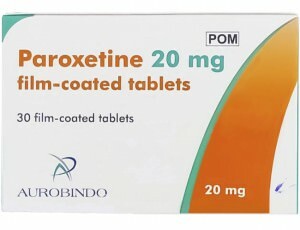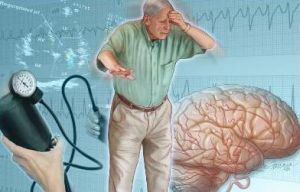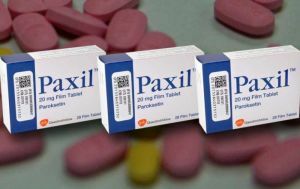 Paroxetine( Paroxetine) is a sufficiently studied psychotropic drug and refers to antidepressants of the new generation. This drug belongs to the group of selective serotonin reuptake inhibitors.
Paroxetine( Paroxetine) is a sufficiently studied psychotropic drug and refers to antidepressants of the new generation. This drug belongs to the group of selective serotonin reuptake inhibitors.
Paroxetine is characterized by the fact that it quickly eliminates the symptoms of depression and has anxiolytic( anxiety-debilitating) action.
The drug refers to highly effective neurostimulants and has a wide spectrum of antidepressant activity. The drug is widely used in psychiatry. This psychotropic drug has a tolerable tolerability and a small number of side effects.
Contents
- Formulation and composition of the preparation
- Pharmacological profile
- Pharmacokinetics of the drug
- When is the
- prescribed? Limitations for the admission
- How to take this antidepressant
- Excess dose
- What measures are taken in case of an overdose?
- Side effects
- Special patients and situations
- Real experience with
- Purchase of the drug and the selection of analogues
Form release and formulation of the drug
The drug is available in the form of tablets that are coated with film-film. Each tablet has a round shape with a radius of 0.8 mm. It is convex, has a rough surface, in the middle is divided by risk.
The main active substance of the drug is paroxetine hydrochloride hemihydrate in an amount of 22.76 mg.
Additional substances of this agent are:
- calcium hydrophosphate;
- elements of cellulose microcrystalline;
- magnesium stearate;
- crospovidone;
- Copovidone;
- talcum powder.
The tablet shell consists of hypromellose, macrogol 6000, titanium dioxide.
Tablets are packed in cardboard boxes, each blister contains 10 pieces. There may be packages of 3 blisters and 6 plates each.
Pharmacological profile

Structure of paroxetine hydrochloride hemihydrate
The drug has antidepressant effect.
The structure of the drug is bicyclic, which distinguishes it from other similar drugs.
The antidepressant effect of this remedy is quite high, already on the third day after the beginning of its use, a positive result can appear, and after 2-3 weeks Paroxetine relieves the symptoms of panic disorder and anxiety.
The action of the drug is associated with blocking the seizure of serotonin, which leads to an increase in its activity in the central nervous system.
Many forms of depression are associated with a shortage of serotonin in the brain. Paroxetine effectively influences the level of this mediator in the central nervous system.
It acts quite gently, without disturbing the psychomotor functions, does not lead to significant changes in blood pressure and seresis. The holinolytic effect of this antidepressant leads to a rapid reduction in insomnia and anxiety.
Pharmacokinetics of the drug
After taking the drug, it is quickly absorbed from the digestive tract and metabolized through the liver. Further, the active ingredient of the drug spreads between the plasma and the erythrocytes. The medication can be taken with food, it does not affect the absorption of the active substance.
The maximum concentration of the drug in the blood with a single admission occurs in 3-10 hours. The connection of the basic substance with proteins is quite high - up to 95%.Steady concentration of this medication in the body occurs after 1-2 weeks of use.
Paroxetine is half-secreted from plasma for 16-21 hours, which makes it possible to prescribe medication once a day. This system of reception is very suitable for patients who are on treatment outpatient.
In hospital, this allows the medical staff to save time. At high doses and prolonged treatment, nonlinear accumulation of matter in the body is traced. In patients with hepatic insufficiency, the proportion of antidepressant in the blood increases.
The drug is excreted in the urine by 64%, the rest is released through the intestines with bile.
In what cases is
given Paroxetine is taken in such cases:
- With , depression of of any type, including those with severe cases of the disease, accompanied by anxiety. Sometimes it is used in
 as preventive measures to prevent relapses of depressive states.
as preventive measures to prevent relapses of depressive states. - Is prescribed for patients with obsessive-compulsive disorder , and also as their prevention.
- The suffering from panic attacks, open-space phobia and the crowd.
- Patient social phobia leading to anxiety disorders .Infringement is connected with sensation of fear before hit and finding of the person in socially significant places.
- In cases of generalized anxiety disorders .Such people experience tension, anxiety, anxiety throughout the day.
- Patients with with post-traumatic stress state .
- It is assigned to people suffering from nightmares, obsessive thoughts and actions of .
Limitations for the admission of
In what cases is the use of the drug unacceptable:
- with concurrent administration of monoamine oxidase inhibitors, and also for two weeks after their withdrawal;
- in cases of unstable epilepsy;
- for women waiting or feeding a child;
- in cases of hypersensitivity to the drug;
- for children under 14 years.
Caution should be given to taking Paroxetine for people with renal insufficiency, prostatic hyperplasia, mania, heart pathologies, a convulsive syndrome in an anamnesis.
It is undesirable to use medication with angle-closure glaucoma, during the passage of electromagnetic therapy, in cases of taking medications that increase the likelihood of bleeding.
How to take this antidepressant
 Paroxetine is taken orally once a day, preferably in the morning. Ideally, this is done during meals to reduce the likelihood of such side effects as vomiting and nausea. The tablet is washed down with a small amount of water.
Paroxetine is taken orally once a day, preferably in the morning. Ideally, this is done during meals to reduce the likelihood of such side effects as vomiting and nausea. The tablet is washed down with a small amount of water.
Like other antidepressants, Paroxetine requires a long course of therapy. The duration of treatment with this drug starts from 6 weeks and can last up to 6 months.
Some patients are given a constant maintenance dose in minimum quantities( in cases where it is impossible to refuse the medication).
Dosage of the drug depending on the disease:
- With depressive disorders , the minimum daily dose of the drug is 10 mg. The optimal dose of medication for depression is 20 mg per day. In cases of pronounced depressive state or when developing resistance to treatment in the body, up to 50 mg of medication per day is prescribed.
- The initial dose for obsessive-compulsive disorder is 20 mg per day, then it is adjusted to 40 mg. The maximum daily dose is 60 mg.
- In cases of panic attacks, , the average therapeutic dose is 40 mg per day. Treatment in this case begins with 10 mg, so as not to cause exacerbations of panic conditions.
- Patients suffering from with social phobia or undergoing stress are prescribed 20 mg of substance on average per day. This dose can be increased up to 50 mg, depending on the patient's condition.
Older people, as well as depleted and weakened patients, are prescribed up to 40 mg of medication per day.
Excess dose
Most often, an overdose of paroxetine is accompanied by drowsiness, nausea, tremors, tachycardia, confusion, vomiting, dizziness. 
Sometimes there are cases of coma. Extended pupils are the first sign of an overdose.
Sometimes excessive use of the drug can cause ventricular dysrhythmia, increased pressure, aggressive behavior, fainting, hypotension, stupor.
Undesirable manifestations at elevated doses are dystonia, bradycardia, liver problems, serotonin syndrome, manic reflex, difficulty urinating.
What measures are taken in case of an overdose?
First of all, gastric lavage is performed using activated charcoal. Physicians should monitor the conductance of airways, oxygenation and ventilation of the lungs.
It is always necessary to monitor the heart rate and other functions.
Side effects of
Side effects of Paroxetine may appear on various organs and systems:
- On the central nervous system , it can act as follows: headaches, excessive nervousness, nightmarish dreams, increased anxiety or drowsiness. Sometimes memory and concentration of attention is disturbed. There are cases of violation of thinking, there are epileptic seizures, paranoia, euphoria, excessive aggression, manifestations of autism and stupor. Rare cases of side effects are hallucinations.
- This nervous antidepressant can affect the nervous system in the following way: sweating increases, dry mouth appears.
- The drug also sometimes has a negative effect on the cardiovascular and lymphatic system of .The main complications can be: high blood pressure, tachycardia, lowering of pressure, bradycardia.

- Excessive medication sometimes has undesirable effects on the vision and senses .Sometimes it is accompanied by the dilatation of the pupils, pain in the eyes, noise in the ears, the appearance of cataracts, conjunctivitis, glaucoma.
- The sexual and urinary system sometimes suffers from the use of medication. Sexual desire is reduced, there are problems with urination.
- The digestive system can react to the drug with nausea, vomiting, constipation, diarrhea. Often patients gain weight.
- Sometimes causes allergic reactions such as malaise, chills, facial swelling, migraine and fainting due to medication.
Special patients and situations
It is contraindicated to take Paroxetine during pregnancy and during lactation. Cautiously prescribed medicine for liver and kidney failure. It is not recommended to use the medication for children under 14 years.
Strictly forbidden to use it with alcohol. To avoid the emergence of neuroleptic syndrome, caution should be exercised in patients taking antipsychotics.
Real experience with
The opinion of practicing physicians and reviews of patients receiving or taking Paroxetine.
I received the following case for taking Paroxetine. Three years ago, I got into a car accident, after suffering the stress, I developed a terrible depression. I had to go to a psychiatrist who advised me to drink this antidepressant.
After 2 months my condition improved a lot: I began to get enough sleep, disorientation and fear of going out into the street disappeared. The only negative that during the treatment could not drive a car, the reaction was dulled. This medicine really pulled me out of the abyss.
Victor, 34 years old
I work as a foreign language teacher at school, I follow my mental and physical health very much, but as a result of constant stress I got panic attacks. My life turned into hell, it got to the point where I turned to the clinic.
I was saved by Paroxetine. Under the guidance of an experienced doctor a month later, I felt like a healthy person, although it was a little problematic to give up the drug. Do not be afraid to seek help from a psychotherapist!
Anya, 29years old
Paroxetine is a new generation antidepressant. It has an anxiolytic, timoanaleptic sedative, stimulating effect. Indeed, until recently, only "old" antidepressants have been used to treat many patients.
The reason for this was stereotypes, many specialists worked out of habit. This drug has a higher cost, but the situation is changing and the use of this drug is gaining more turns. The company "Pliva"( Croatia) has developed an excellent means of getting rid of depressions.
Svetlana Nikolaevna, doctor-psychotherapist
Many patients in depressive states I prescribe Paroxetine. In psychiatry, I work only 3 years, but the medicinal properties of this drug have already been able to notice.
This is a very effective, but rather "heavy" antidepressant, which requires strict adherence to the doctor's recommendations and I maintain clear control over each patient.
Violations of the psychic sphere after receiving this drug are rare. I recommend colleagues not to be afraid to use this antidepressant in their practice.
Anna Vasilievna, psychotherapist
Purchase of the drug and selection of analogues
 This medication is dispensed in the pharmacy only on the prescription of a psychiatrist. Storage of the medicine should be in a dark place at a temperature not exceeding 25 degrees.
This medication is dispensed in the pharmacy only on the prescription of a psychiatrist. Storage of the medicine should be in a dark place at a temperature not exceeding 25 degrees.
The shelf life of this drug is three years.
The price of 20 tablets of Paroxetine in Russia is about 400 rubles, the pharmacy has the following analogs: Paxil, Reksetin, Adress.



